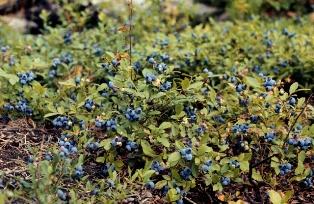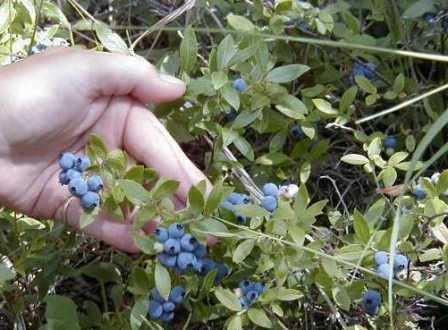Blueberry Production in Manitoba
- Economics and Marketing
- Site Selection
- Planting/Transplanting/Plant Material
- Fertilizer
- Weed Control
- Insects
- Diseases
- Irrigation
- Harvesting
- Renovation
Description

The blueberry or lowbush blueberry is a slow-growing, long-lived woody perennial. The main species in the northern part of the province is Vaccinium angustifolium and the main species in southern Manitoba is Vaccinium myrtilloides. The blueberry is a member of the Heather family. It is closely related to azaleas, rhododendrons, and cranberries. Blueberries are native to Canada and range from the far north to the south. Manitoba wild blueberries have been found to contain 310% of the recommended daily intake of vitamin C per 100g of fruit.
Uses
The blueberry was an important food source for both indigenous peoples and the early pioneers. Blueberries are an also important food source for wildlife during the summer. Blueberries can be eaten fresh, or used in pie fillings, jams, jellies, syrups, juice, wine, and flavour concentrates as well as components of baked goods.
Economics and Marketing
Currently in Manitoba there is no planted fields or commercially managed wild stand of blueberries. There is a small cottage industry built around unmanaged stands and selling the product. All the blueberries picked are sold in the local market. Based on several test plots it does not appear that a commercial operation is possible in Manitoba. More trials on adapting techniques used in Eastern Canada need to be studied. However, this should not deter anyone from attempting to start a commercial operation. They need to remember that under limited test conditions it has been proven unsuccessful.
Site Selection
Blueberries have very specific soil requirements which greatly limit the areas where they can be produced in Manitoba. The soil should be free of large stones. Open, porous soils such as sandy loam or course sands high in organic matter are well suited for blueberry production. Clay soils high in organic matter can be used but they must be acidic. Peat and muck soils are not suited for blueberries. Blueberries require a soil pH of 4.5 to 5.5 for good growth and optimum fruit production. Soils higher than pH 5.8 can cause iron chlorosis and reduced plant growth and yield. A site with a nearby water source is beneficial. A sheltered location from the wind by shelterbelts or natural tree bluffs protect the plants from wind damage, and prevents the snow from being blown off the plants.
Planting/Transplanting/ Plant Material
There are three potential commercial blueberry operations for Manitoba. The first is to manage wild stands of low bush blueberries, the second is a planting of low bush blueberries, and the third is a planting of half-high blueberries. Low bush blueberries are native to Canada and have a height of seven to 38 cm. Half-high plants are a cross between low bush and highbush blueberries and have a height of 50 to 60 cm. However, very little research into either method limits the potential development of blueberry production in Manitoba. Current information is based on information from other provinces and states
Managing Wild Stands
Commercial blueberry production in Nova Scotia, Quebec, and Saskatchewan is based primarily on managing wild blueberry stands. In Manitoba, managing wild stands holds the most potential for establishing a blueberry industry. In some recent work done in Northern Manitoba using V. myrtilloides it was found that it was possible to grow blueberries using managed stand principles from Eastern Canada. However, yields were too low to be economically viable. It was suggested that the study needs to be repeated using V. angustifolium, found in more southern parts of Manitoba, which is known to have higher yields.
Establishing Lowbush Blueberries
Research in this area by Manitoba Agriculture, Food and Rural Initiatives indicates that establishing lowbush blueberries can be slow and time consuming and might not be the most economic way to plant lowbush berries because of difficulties in propagating enough material to plant in the field. Similarly, consultation with representatives of the Nova Scotia industry has revealed that not much has changed. Establishing lowbush blueberry plantings is generally considered to be uneconomical, particularly where there are native stands available. In the absence of accessible wild stands however, establishment of a lowbush planting may be worth investigating.
Establishing Half-high Blueberries
Most half-high blueberries were developed out of the University of Minnesota. There are several cultivars which may be suited for growing in Manitoba (Table 1). Blueberries should be transplanted in the spring using one to two-year-old plants. Based on information from Minnesota, plant bushes recommendations are to plant about one meter apart and rows about two meters apart. On fields with closer plantings more plants are required per acre. Plants will require winter protection of either straw or a synthetic insulating material. Also, it is strongly recommended that the plants have at least a 30 cm snow cover.
Table 1 - Half-high cultivars which may be suited to southern Manitoba growing conditions
| Cultivar | Hardiness Zone (2) | Estimated Yield (3) | Height | Fruit characteristics |
| North Blue | 3 - 5 | 3 to 7 lbs 1.3 to 2.3 kg |
20 to 30 in. 50 to 75 cm |
dark blue good fresh flavour |
| North Country | 3 - 5 | 2 to 7 lbs 1 to 3 kg |
18 to 24 in. 45 to 60 cm |
sky-blue sweet to mild flavour |
| North Sky (1) | 3 - 5 | 1 to 2 lbs half to 1 kg |
10 to 18 in. 25 to 45 cm |
good quality high in flavour |
| St. Cloud | 3 - 5 | 3 - 9 lbs | 30-50 in. tall 40-60 in. wide |
Medium, dark blue, firm berries; sweet flavor, crisp texture; good storage capability; ripens 5 days earlier than "Northblue". Requires second cultivar for pollination. |
| Polaris | 3 - 5 | 3-10 lbs | 20-50 in. tall 30-60 in. wide |
Medium-large berries very firm; very crisp texture; intense aromatic flavor; excellent storage capability; ripens 7 days earlier than "Northblue". Requires second cultivar for pollination. |
| Chippewa | 3 - 5 | 3-12 lbs | 20-50 in. tall 30-60 in. wide |
Medium-large berries; sky-blue color; sweet flavor; firm fruit; ripens with "Northblue". Yield and berry size benefit from cross pollination. |
| Northland | 3 - 5 | 3-12 lbs | 30-50 in. tall 40-60 in. wide |
Medium-large berries; mild flavor. Ripens 3 days after "Northblue". |
| ||||
| Source: Commercial Blueberry Production in Minnesota and Wisconsin Commercial blueberry production in Minnesota and Wisconsin | UMN Extension | ||||
Fertilizer
Fertility recommendations should be based on soil analysis before planting. Tests should be repeated on a regular basis. Foliar tests are also recommended to determine what the nutrient status is within the plant. Often visual assessments of crop vigour or leaf tissue can indicate which nutrients are missing. When fertilizing blueberries, use nitrogen in the ammonium form such as ammonium nitrate. Urea can also be used because it breaks down to an ammonium form. Both nitrogen sources lower the pH of the soil which is beneficial to the blueberries compared to other sources which can raise soil pH.
Weed Control
Weeds are a problem in blueberries because blueberries are long-lived perennial crops. There are no herbicides registered for use on blueberries in Manitoba. Cultural controls are necessary such as hand weeding. In wild managed stands, periodic burns or mowing can help to control weeds. Elimination of as many weeds before planting is essential to the long term viability of planted blueberry commercial fields.
Insects
Blueberries are subject to attack from many different insects. Growers should monitor fields regularly to determine if these insects are present. However, growers should only spray when levels of insects are at threshold levels and economic losses will occur if the insects are not controlled. This list provides the names of the most common and problematic insects to blueberries in Manitoba:
- blueberry blossom weevil
- blueberry leafminer
- blueberry maggot
- blueberry stem borer
- cherry fruitworm
- cranberry fruitworm
- cranberry rootworms and grubs
- plum curculio
Other pests include deer and birds. Birds can be scared away with various devices or netting can be placed over the entire field, for a much higher cost, if scare devises are ineffective.
Diseases
Blueberries can be attacked by a host of fungus, bacteria, and viruses. The lack of blueberries under cultivation makes it difficult to know which diseases might be a problem under monoculture. It is not known for certain if all the diseases are present in Manitoba. This list identifies which diseases can potentially be a problem on blueberries:
- mummyberry
- fusicoccum (Godronia) Canker
- phomopsis Canker
- botrytis
- anthracnose
- alternaria fruit root
- red leaf disease
- powdery mildew
- crown gall (bacteria)
- shoestring
- nectrotic and red
- ringspot
- blueberry leaf mottle
- mosaic
- stunt
Irrigation
Blueberries have a shallow and fibrous root system which requires frequent light waterings. Mature plants require about 25 mm a week during the growing season and harvest. Most often overhead sprinklers are used but drip systems could also be used. The advantage of overhead irrigation when compared to drip irrigation is overhead irrigation can be used for frost protection and crop cooling. However, it wastes more water through evaporation and can raise disease levels due to wet foliage.
Harvesting
Blueberries are ripe three to six days after they turn blue. Harvest should begin when 90% of the fruit is ripe. Harvesting can be done as a U-pick, manually for pre-picked, through bicycle-wheel mounted push harvesters and mechanical harvesters. It is important to select the right method which can be based on many factors. For example mechanical harvesting would not be suitable for the fresh market because the harvester is not selective enough or for locations with uneven terrain.

Renovation
Managed wild stands require periodic renovation. This is done either by burning or by mowing. Blueberries need to be renovated every two to three years by removing all of the above ground vegetation to promote more vigorous and productive growth from rhizomes. Both methods work well. Fields can be burned by using oil or propane burners or placing straw on the field and setting the straw on fire. This removes all old growth cleaning the field of diseases and insects. Mowing is much cheaper and involves cutting the plants to a height of less than 3 cm.

